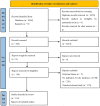Catastrophic health expenditure, incidence, trend and socioeconomic risk factors in China: A systematic review and meta-analysis
- PMID: 36684860
- PMCID: PMC9846062
- DOI: 10.3389/fpubh.2022.997694
Catastrophic health expenditure, incidence, trend and socioeconomic risk factors in China: A systematic review and meta-analysis
Abstract
Objective: To evaluate the incidence and trend of catastrophic health expenditures (CHE) in China over the past 20 years and explore the socioeconomic factors affecting China's CHE rate.
Methods: The systematic review was conducted according to the Cochrane Handbook and reported according to PRISMA. We searched English and Chinese literature databases, including PubMed, EMbase, Web of Science, China National Knowledge Infrastructure (CNKI), Wan Fang, China Science and Technology Journal Database (CQVIP), and CBM (Sino Med), for empirical studies on the CHE rate in China and its associated socioeconomic factors from January 2000 to June 2020. Two reviewers conducted the study selection, data extraction, and quality appraisal. The secular trend of the CHE rate was examined, and factors associated with CHE were explored using subgroup analysis and meta-regression.
Results: A total of 118 eligible studies with 1,771,726 participants were included. From 2000 to 2020, the overall CHE rate was 25.2% (95% CI: 23.4%-26.9%) in China. The CHE rate continued to rise from 13.0% in 2000 to 32.2% in 2020 in the general population. The CHE rate was higher in urban areas than in rural areas, higher in the western than the northeast, eastern, and central region, in the elderly than non-elderly, in low-income groups than non-low-income groups, in people with cancer, chronic infectious disease, and cardio-cerebrovascular diseases (CCVD) than those with non-chronic disease group, and in people with NCMS than those with URBMI and UEBMI. Multiple meta-regression analyses found that low-income, cancer, CCVD, unspecified medical insurance type, definition 1 and definition 2 were correlated with the CHE rate, while other factors were all non-significantly correlated.
Conclusion: In the past two decades, the CHE rate in China has been rising. The continuous rise of health expenditures may be an important reason for the increasing CHE rate. Age, income level, and health status affect the CHE rate. Therefore, it is necessary to find ways to meet the medical needs of residents and, at the same time, control the unreasonable rapid increase in health expenditures in China.
Keywords: catastrophic health expenditure; influencing factors; meta-analysis; social-economic risk factors; systematic review.
Copyright © 2023 Zhang, Jiang, Yang, Zou and Chen.
Conflict of interest statement
The authors declare that the research was conducted in the absence of any commercial or financial relationships that could be construed as a potential conflict of interest.
Figures
Similar articles
-
Do health insurances reduce catastrophic health expenditure in China? A systematic evidence synthesis.PLoS One. 2020 Sep 24;15(9):e0239461. doi: 10.1371/journal.pone.0239461. eCollection 2020. PLoS One. 2020. PMID: 32970740 Free PMC article.
-
Economic status and catastrophic health expenditures in China in the last decade of health reform: a systematic review and meta-analysis.BMC Health Serv Res. 2021 Jun 24;21(1):600. doi: 10.1186/s12913-021-06408-1. BMC Health Serv Res. 2021. PMID: 34167527 Free PMC article.
-
Income related inequality and influencing factors: a study for the incidence of catastrophic health expenditure in rural China.BMC Public Health. 2017 Sep 20;17(1):727. doi: 10.1186/s12889-017-4713-x. BMC Public Health. 2017. PMID: 28931392 Free PMC article.
-
Can the reform of integrating health insurance reduce inequity in catastrophic health expenditure? Evidence from China.Int J Equity Health. 2020 Apr 3;19(1):49. doi: 10.1186/s12939-020-1145-5. Int J Equity Health. 2020. PMID: 32245473 Free PMC article.
-
Chronic diseases and catastrophic health expenditures in elderly Chinese households: a cohort study.BMC Geriatr. 2025 Apr 24;25(1):272. doi: 10.1186/s12877-025-05692-4. BMC Geriatr. 2025. PMID: 40275208 Free PMC article.
Cited by
-
How did the urban and rural resident basic medical insurance integration affect medical costs?-Evidence from China.PLoS One. 2025 Jul 18;20(7):e0325614. doi: 10.1371/journal.pone.0325614. eCollection 2025. PLoS One. 2025. PMID: 40679990 Free PMC article.
-
Changing inequity in health service utilization and financial burden among patients with hypertension in China: evidence from China Health and Retirement Longitudinal Study (CHARLS), 2011-2018.Int J Equity Health. 2023 Nov 24;22(1):246. doi: 10.1186/s12939-023-02062-7. Int J Equity Health. 2023. PMID: 38001484 Free PMC article.
-
Letter to the Editor.J Health Econ Outcomes Res. 2023 Apr 12;10(1):89. doi: 10.36469/001c.74185. eCollection 2023. J Health Econ Outcomes Res. 2023. PMID: 37064294 Free PMC article.
-
The impact of the urban-rural residents' medical insurance integration on rural residents' out-of-pocket medical costs: based on the deductible, reimbursement rate, and ceiling line.Front Public Health. 2025 Apr 8;13:1576978. doi: 10.3389/fpubh.2025.1576978. eCollection 2025. Front Public Health. 2025. PMID: 40265068 Free PMC article.
-
Cancer Burden and Attributable Risk Factors of Cancers in China: Epidemiological Insights and Comparisons With India.Cancer Control. 2024 Jan-Dec;31:10732748241276674. doi: 10.1177/10732748241276674. Cancer Control. 2024. PMID: 39240012 Free PMC article.
References
-
- Xu K. Distribution of health payments and catastrophic expenditures. In: Distribution of Health Payments and Catastrophic Expenditures Methodology (2004).
-
- Gabriela F, Daniel H, Gretchen S, Justine H, Sarah T, Tamás E, et al. . Tracking Universal Health Coverage: 2017 Global Monitoring Report. Geneva: World Health Organization and World Bank; (2017).
Publication types
MeSH terms
LinkOut - more resources
Full Text Sources
Miscellaneous




